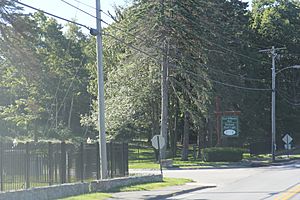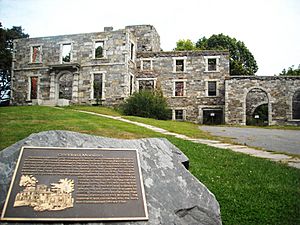Fort Williams Park facts for kids
Fort Williams Park is a large, beautiful park in Cape Elizabeth, Maine. It covers 90 acres and is home to many important historical places. The park is most famous for having the Portland Head Light, a well-known lighthouse, right on its grounds. It also includes the former United States Army base called Fort Williams, which was used during World War I and World War II.
Contents
Historic Places to Explore
Portland Head Light
Portland Head Light is a famous lighthouse located within Fort Williams Park. Its construction started way back in 1787, ordered by George Washington himself! It was finished on January 10, 1791.
Today, this white lighthouse stands 80 feet tall from the ground and 101 feet above the water. It has a very bright light that can be seen from 24 miles away, helping ships find their way. The land and the old keeper's house belong to the town of Cape Elizabeth. However, the light and fog signal are looked after by the U.S. Coast Guard, as it's still an active aid for ships navigating the coast.
Goddard Mansion
The Goddard Mansion is a cool ruin you can see inside Fort Williams Park. It was built between 1853 and 1859 for Colonel John Goddard. He was a businessman who also led a group of soldiers, the 1st Maine Volunteer Cavalry Regiment, for a few months during the American Civil War.
Later, in 1900, the U.S. government bought the mansion when they were making Fort Williams bigger. It was then used as living quarters for soldiers and even had a club for them in the basement. Today, you can still see the remaining walls of the mansion standing on a hill, looking out over the park.
Fort Williams Army Base
Fort Williams was a base for the United States Army. It was active from 1872 until 1964.
The area around Portland Headlight started to become a fort in 1896 when the first big guns, called batteries, were put in place. By 1899, it was officially named Fort Williams. In 1900, the Army bought more land, and the fort grew a lot. They built barracks (places for soldiers to sleep), officers' quarters (homes for commanders), a hospital, and more.
When the United States joined World War I in 1917, Fort Williams was put on high alert. Before the war, each battery had about 80-100 soldiers. But because the war was ending and the German Navy was no longer a big threat, many soldiers from Fort Williams were sent to fight in Europe.
During World War II, starting in 1939, the fort was very busy again with many soldiers. After the attack on Pearl Harbor, when they tested the old batteries, the shock wave from the guns was so strong it damaged nearby buildings! By 1944, all the original big guns were removed. The fort then became a place for managing army operations. Fort Williams stayed an administrative headquarters until 1964, when the town of Cape Elizabeth bought the property.
Fort Williams Park Today
After many ideas for what to do with the land, the town of Cape Elizabeth decided on July 23, 1979, to make it Fort Williams Park. The park is open to everyone, locals and visitors, and there's no fee to enter.
It's a great place for outdoor activities! You can find tennis courts, a basketball court, and a baseball field. There's also a fitness course, picnic tables, and places to cook out. It's a popular spot for walking, running, and walking your dog. Since everyone visiting Portland Head Light passes through the park, it's a very well-known and loved spot in Maine. The Beach to Beacon 10K race is the park's biggest yearly event.



